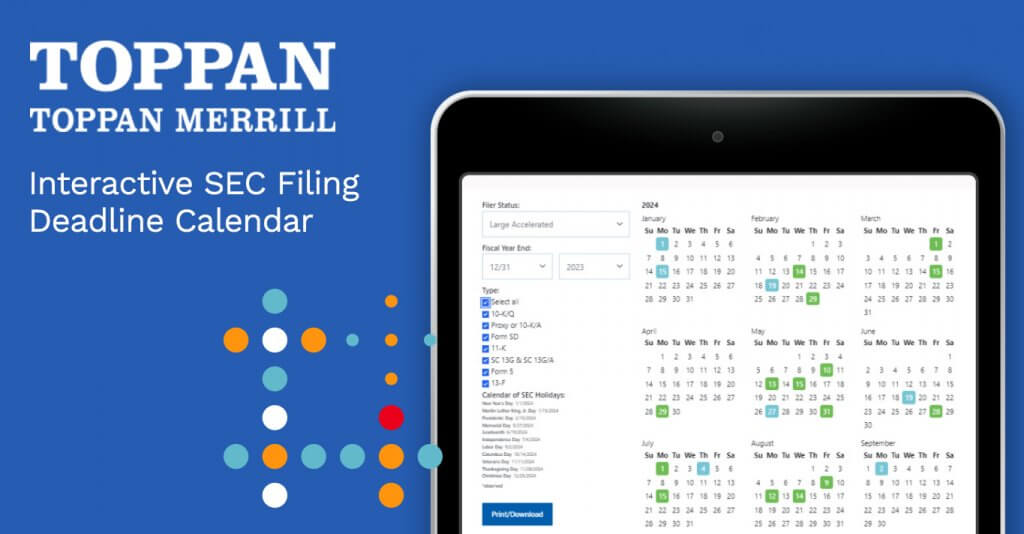
SEC Filings
Whether you are a US filer or Foreign Private Issuer, you feel the ongoing pressures of complex SEC filings and ensuring your company’s financial story is told the way you intended. With expert support and industry-leading technology, Toppan Merrill is your partner to minimize risk and ease the burden of SEC filings.
US Filers
Form 10-K, Form 10-Q, Form 8-K
Foreign Private Issuers
Form 20-F, Form 40-F, Form 6-K
- Lean into Toppan Merrill’s suite of SEC reporting tools to streamline the disclosure content management and submission process
- Leverage your dedicated iXBRL consultant who is with you at every step of the reporting and filing process to ensure accuracy
- Access SEC reporting experts 24/7 to proactively guide your team through the required filings, deadlines and keep you in compliance
- Receive continual insights on industry updates and new regulatory requirements through webinars, events, blogs and articles
Take control of your SEC disclosures with Toppan Merrill Bridge™
Toppan Merrill’s SEC reporting software, Bridge, is a single, secure, integrated SaaS platform backed by 55+ years of financial and regulatory disclosure service and subject matter expertise.
Know Microsoft® Word, Excel® and PowerPoint®? Then you already know Bridge.

iXBRL Filings
XBRL expertise is essential to properly tag your financial statements to ensure that your EDGAR and iXBRL submissions align and accurately communicate your results. Rely on Toppan Merrill’s deep team of XBRL accounting experts to serve as an extension to your reporting team and assist you with your iXBRL filing requirements.
- Founding member and current chair of the XBRL US Data Quality Committee
- Current vice chairman of XBRL US
- Current chair of the XBRL US Communication Steering Committee
- In direct communication with the SEC keeping us ahead of regulatory changes and new requirements
Rely on the speed, accuracy and expertise of Toppan Merrill.

Interactive SEC Filing Deadline Calendar
Designed exclusively for public corporations and investment management companies. Simply enter your filer status, FYE and form types to view key filing dates.
Access the calendar

Section 16 Compliance
Easily manage a variety of form types in one web-based platform, including Section 16 (Forms 3, 4, and 5), Schedule 13D and 13G, Form 13F, Form D, Form 144 and more.
- Keep track and in control of the information and easily manage Section 16 filer information
- Full setup, onboarding and support
- Service supported with over 50 years of industry expertise.
On The Dot
Podcast: TSR ready. Are you absolutely sure? Tackling the data and content management challenges. [9:12]
A conversation with Guy Stanzione about the SEC Tailored Shareholder Reports mandate and tackling the data and content management challenges at the share class level.
Updates and Insights

Canada’s Supply Chains Act: What to consider when preparing your first report

SEC Climate Disclosure Rule: Timing Uncertain as Legal Challenges Move to Eighth Circuit

SEC Adopts Climate Reporting Requirements
“Professional, timely, accurate service in getting our project done expeditiously. I couldn't ask for a better, more responsive team!”Chief Financial Officer, Pharmaceutical Manufacturing Industry
Related Solutions
Annual Meeting & Proxy Solutions
SOX Compliance
SEC Connect
Contact our team to get started.
Phone
Have more questions?
Reduce complexity and get answers to some of our customers’ frequently asked questions.
See the full list of FAQsSEC Form 10-K is a report that public companies are required to file annually after the fourth fiscal quarter with the SEC. In accordance with the Securities Exchange Act of 1934, SEC Form 10-K needs to be filed with the SEC within a certain amount of time after the end of the fiscal year based on the company’s filer status: 60 days for Large Accelerated filers, 75 days for Accelerated filers and 90 days for all other filers.
Similar to the annual report, SEC Form 10-K provides investors with a comprehensive view of the company’s financial position and additional business disclosures, such as key operational details, market risks and corporate governance. All Form 10-Ks filed with the SEC are also publicly available on the SEC’s EDGAR online filing system. For support and additional information, explore our SEC reporting solutions.
SEC Form 10-Q is a performance report that public companies are required to file with the SEC on a quarterly basis for the first three quarters of the fiscal year. In accordance with the Securities Exchange Act of 1934, it provides investors with an ongoing, comprehensive view of a company’s financial position during the year, including unaudited financial statements. Each quarterly report generally compares the prior quarter to the current one, and the same quarter last year to the current one.
A company’s Form 10-Q must also be provided to any shareholder upon request, though are usually made available on the website. All Form 10-Qs filed with the SEC are also publicly available on the SEC’s EDGAR online filing system. For support and additional information, explore our SEC reporting solutions.
SEC Form 20-F is the primary disclosure document required of foreign private issuers listing equity shares on exchanges in the United States. Form 20-F is most often filed with the SEC as an annual report but is also used to register classes of securities. Companies with fewer than 50% of its voting shares held by U.S. investors can file this form.
Under the Securities Exchange Act of 1943, Form 20-F is meant to help standardize reporting requirements so investors can evaluate foreign-based companies’ equities alongside U.S.-based companies’ equities. Accordingly, Form 20-F disclosures are very similar to those required of U.S. issuers, reporting information such as key operational details, market risks, corporate governance and financial statements.
However, there are two main differences. First, if a foreign private issuer prepares financial statements in accordance with home-country accounting standards or, not to IASB (International Accounting Standards Board) and IFRS (International Accounting Standards Board International Financial Reporting Standards), foreign private issuer must also furnish reconciliation with US GAAP (Generally Accepted Accounting Principles). Second, foreign private issuers are allowed to disclose executive compensation in aggregate and are not required to provide a Compensation Discussion & Analysis.
Form 20-F is filed and displayed publicly on the SEC’s EDGAR system. For support and additional information, explore our SEC reporting solutions.
SEC Form 40-F, also known as the Registration and Annual Report for Canadian Securities Form, is a filing with the SEC used by Canadian companies that want to offer their securities to United States investors.
In addition to being used to register Canadian securities in the United States, Form 40-F provides investors with valuable insight into the Canadian companies offering them. After the first filing with the SEC, the form is thereafter used by Canadian companies to provide their annual report. The form not only supplies standard information about the security and the company, it also gives the domestic and Canadian contact information for the securities issuer.
Form 40-F may be used by a company that’s incorporated or organized in Canada, is a foreign private issuer or crown corporation, has been subject to reporting to any Canadian regulatory authority for at least 12 months, and possesses outstanding equity shares valued at $75 million or more, or a Form F-9 filed with the SEC on or before Dec. 30, 2012.
Once filed, Form 40-F is accessible to public scrutiny on the SEC’s EDGAR computer system for the receipt, acceptance, review and dissemination of documents submitted in electronic format to the SEC. For support and additional information, explore our SEC reporting solutions.
Whenever a U.S. public company experiences any event of importance to shareholders or the SEC, whether a major material event or significant corporate change, Form 8-K must be filed with the SEC within four business days. The form gives the name and description of the events and includes relevant exhibits, like press releases, financial statements and data tables. It serves as an update to Form 10-Q quarterly reports and Form 10-K annual reports that the company already has on file with the SEC.
In compliance with the Securities Exchange Act of 1934, Form 8-K announces events — like an acquisition, bankruptcy, removal of a director or change in the fiscal year — on a current, as-needed basis. The wide variety of events that warrant filing the form can be related to a company’s business and operations, accounting and finances, market performance and activities, corporate leadership, asset-backed securities, regulation fair disclosure (FD) and other areas of interest.
Form 8-K filings are displayed publicly on the EDGAR computer system for the receipt, acceptance, review and dissemination of documents submitted in electronic format to the SEC. Most large companies also make their Form 8-Ks available on their own websites, in the Investor Relations or similarly titled section. For support and additional information, explore our SEC reporting solutions.
SEC Form 6-K is submitted by specific foreign private issuers to the SEC to keep investors aware of information the issuers distribute outside of the United States.
The only SEC submission required of foreign issuers outside of annual reports, the Form 6-K or Exchange Act Form, aims to ensure cross-border transparency of information and investor protection. Form 6-K is used to report any material information that a foreign issuer makes public in its home country, files publicly with its home country stock exchange, or distributes to its security holders.
Form 6-K also serves as a means of reporting any other significant information arising between annual reports and often includes copies of the foreign issuer’s latest financial reports, like income statements, cash-flow statements and balance sheets.
Foreign issuers submit Form 6-K to the SEC electronically. Once filed, it’s displayed publicly using the EDGAR computer system for the receipt, acceptance, review and dissemination of documents submitted in electronic format to the SEC. A record that shows “6-K/A” is an amended Form 6-K, submitted when material information has changed. For support and additional information, explore our SEC Reporting solutions.
SEC Section 16 of The Securities Exchange Act of 1934 requires corporate insiders to publicly disclose their company affiliations, material changes in their holdings or unreported insider transactions through various regulatory filings with the SEC. Specifically, Section 16 mandates that Forms 3, 4 and 5 be filed by insiders—in other words, company investors who are directly or indirectly beneficial owners of more than 10% of stock in a company or directors and officers of the issuer of the securities. An insider of a first-time securities issuer or a new insider at an already-registered securities issuer must carry out the initial filing, Form 3. Form 4 is used to report material changes in insiders’ holdings. Form 5 reports any transactions that should have been included on a previous Form 4 or were eligible for deferred reporting such as gifts of shares or multiple small transactions. Section 16 reporting must be submitted electronically through the EDGAR computer system for the receipt, acceptance, review and dissemination of documents submitted in electronic format to the Commission. The SEC also requires companies to post the forms on their websites by the end of the next business day after filing them. Section 16 reporting deadlines were accelerated due to provisions of the SOX, the Sarbanes-Oxley Act of 2002. For support and additional information, explore our solutions here.